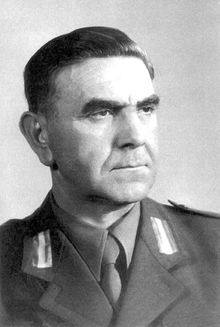Ante Pavelić
![]()
The title of this article is ambiguous. For the vice-president of the National Council of the SHS state, see Ante Pavelić (politician, 1869).
Ante Pavelić [![]()
![]() ˈaːntɛ ˈpavɛliʨ] (* 14 July 1889 in Bradina near Konjic, Bosnia and Herzegovina; † 28 December 1959 in Madrid) was a Yugoslav jurist, politician and war criminal. He was the fascist dictator of the Independent State of Croatia (NDH) from 1941 to 1945.
ˈaːntɛ ˈpavɛliʨ] (* 14 July 1889 in Bradina near Konjic, Bosnia and Herzegovina; † 28 December 1959 in Madrid) was a Yugoslav jurist, politician and war criminal. He was the fascist dictator of the Independent State of Croatia (NDH) from 1941 to 1945.
Pavelić was a member of the Croatian Party of the Right and a member of the Yugoslav parliament from 1927 to 1929. After the proclamation of the royal dictatorship by Alexander I in 1929, he went into exile, where he founded the fascist Ustasha movement in the same year. During the Second World War and after the Axis invasion of Yugoslavia in 1941, Pavelić was proclaimed leader (poglavnik) of the newly formed Ustasha Croatia by agreement of the German and Italian occupying powers.
Backed by the Ustasha militia and secret police, he established a totalitarian dictatorship that persecuted opponents of the regime, set up concentration camps and committed genocide against hundreds of thousands of Serbs and tens of thousands of Jews and Roma. After the end of the war, Pavelić fled via monastic routes to Argentina, Paraguay and Spain, where he died in 1959.
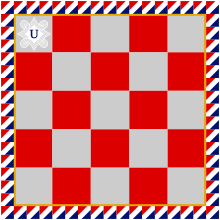
Standard of the Leader of the Independent State of Croatia
Live
Youth and education
Due to his father's changing places of work, Pavelić attended elementary schools in Gjulhisar and Jajce, as well as high schools in Travnik, Senj, Karlovac and Zagreb. After graduating from high school, he studied law at the University of Zagreb. At the university he became the spokesman for the student organization Mlada Hrvatska (Young Croatia). His role model was the founder of the Croatian national movement Ante Starčević. After receiving his doctorate in law in 1915, Pavelić opened a law firm in Zagreb.
Political activity
Pavelić became secretary of the "Croatian State Law Party", which sought Croatian independence after the founding of Yugoslavia and maintained good contacts with Croatian emigrants abroad. In 1922 he was elected to the Zagreb City Council and in 1928 to the Yugoslav Parliament in Belgrade. There he advocated Croatian independence. He reacted to the Yugoslav royal dictatorship by forming an armed conspiratorial group that carried out assassinations of pro-Yugoslav Croats.
Exile after the establishment of the royal dictatorship
He left the Kingdom of Yugoslavia on 17 January 1929 to fight the Yugoslav royal dictatorship from abroad. He went into exile in fascist Italy, where he founded the Croatian independence movement Ustasha and led its liberation struggle in his homeland, conducted by terrorist means. In absentia, an "exceptional court for the protection of the state" in Belgrade imposed a death sentence on Pavelić. Significantly, the basis for the sentence was not Yugoslav law, but rather the Serbian penal code.
Ante Pavelić and the Ustasha he led were also involved in the assassination of King Alexander I of Yugoslavia and French Foreign Minister Louis Barthou in Marseilles during the state visit on 9 October 1934.
In 1936, Pavelić attempted to highlight the affinities between National Socialism and Croatian nationalism in his memorandum The Croatian Question. This writing was not published, but printed in a numbered small edition with the note "Printed as a manuscript - For official use only" and issued against confirmation of receipt. It was intended to influence German government circles positively in favor of the Ustasha movement. However, mainly for economic reasons, Hitler was at this time more interested in good relations with the Kingdom of Yugoslavia.
In it, he describes as enemies of the Croatian freedom movement:
- the Serbian authorities
- International Freemasonry
- Judaism
- communism.
State leader
After Yugoslavia's capitulation to the Axis powers (April 17, 1941), Ante Pavelić, who was supported by Benito Mussolini, returned to Zagreb as leader (Poglavnik) with dictatorial powers from his many years of exile. The so-called Independent State of Croatia, now led by him, was thoroughly organized as a leader state without separation of powers. In April 1941 Pavelić hurriedly enacted anti-Jewish laws based on the German model. As early as 6 June 1941, Pavelić was received by Hitler on a state visit to the Berghof. The mainstays of his tyranny were militias, military and secret police, special courts and more than 20 concentration camps.
Since it had to cede a large part of the Croatian coast (Istria, Kvarner Bay, Dalmatia) and the Gorski kotar to Italy, but on the other hand larger areas with a majority Croatian population in Bosnia-Herzegovina and Syrmia were annexed to it, more than half of its inhabitants were Roman Catholic Croats in the majority, while just under a third were mainly Orthodox Serbs. Another large group were the present-day Bosniaks, who were then called "Croatian Muslims".
Ante Pavelić ordered a planned genocide of Serbs, Jews, Roma, Orthodox Christians, and Croatian and Muslim opponents of the system (often Communists). The largest Croatian concentration camp was at Jasenovac, where 85,000 Serbs, Jews, Roma, and Croatian opposition members were killed, according to the Simon Wiesenthal Center, and about 56,000 to 97,000 in total, according to the United States Holocaust Memorial Museum. There were several death transports from here to Auschwitz.
German services unsuccessfully expressed requests for Pavelić's removal, but this was rejected by Adolf Hitler.
Exile after the end of the war
In 1945 Pavelić left the fleeing Croatian troops and fled to Argentina via Austria and Italy. In Rome he spent two years with the support of the Vatican, especially the priest and Ustasha functionary Krunoslav Draganović, before he managed to continue his journey to Argentina via the so-called "rat line" organized by Draganović. During his escape, he is said to have carried part of the state treasure with him. In Argentina he founded a government in exile. In Yugoslavia he was sentenced to death in absentia. Pavelić was under the protection of Juan Domingo Perón and after his fall under the protection of Franco.
Assassination
On 10 April 1957, the anniversary of the founding of the Independent State of Croatia, Pavelić was seriously wounded by several shots in the back during an assassination attempt in Lomas del Palomar, Argentina. The assassination may have been instigated by the Yugoslav secret service UDBA. It was probably carried out by the exiled Montenegrin of Serbian origin Blagoje Jovović. In the early 1990s, he commissioned a Serbian journalist to write his biography.
Death
Pavelić died at 3:55 a.m. on 28 December 1959 in the German Hospital in Madrid, possibly from the late effects of his injuries. The first news of Ante Pavelić's death was sent by express telegram to Buenos Aires at 4:00 a.m. on the day of his death, so that all organizations of the Croatian Liberation Movement could be notified. Radio Madrid first broadcast the death news on its midnight news on 30 December. Until that time, no one had officially known of Pavelić's whereabouts.
On 28 December 1959 at 4.30 p.m., after the blessing, his body was taken to the church of Madrid's Cementerio de San Isidro and laid out there until 31 December 1959. On 31 December, Reverend Branko Marić read the Holy Mass "dies obitus presente cadavre". After the Holy Mass, the coffin was opened and those present were able to say their last goodbyes. Afterwards, the burial took place in the same cemetery.
The funeral was attended by Pavelić's family, Croatian, Spanish, Romanian friends and politicians. For example, Horia Sima, who was also in exile in Spain at the time.
Pavelić's tomb is a place of pilgrimage for Croatian nationalists, sympathisers and the curious. For example, the Croatian news website Index published photos of Croatian football star Davor Šuker visiting the tomb during his active time in Spain.
In addition to Pavelić, his wife Maria, his son Velimir and his daughter Višnja are buried in the family grave.
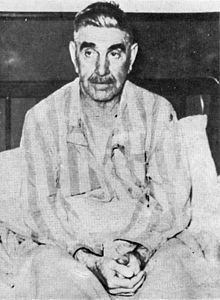
Pavelić in the hospital after the failed assassination attempt (1957).

Pavelić's tomb in Madrid's Cementerio de San Isidro cemetery.
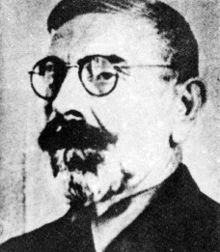
Photo of Pavelić from his forged passport, issued in the name of Pablo Aranjos.
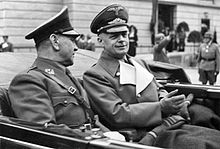
Ante Pavelić (l.) with Joachim von Ribbentrop in Salzburg (June 1941)

Pavelić in Croatian Sabor (1942).
Family
Pavelić was the son of Mile Pavelić (1862-1946) and his wife Marija, called Mara (née Šojat; 1866-1945). He was the second child of the two after his brother Josip (1884-1945). His parents were Bunjevats and lived in the hamlet of Serdari, part of Krivi Put near Senj. His father came from nearby Mrzli Dol and his mother from Francikovac. Pavelić's father was briefly employed as a supervisor of state railway construction works.
Pavelić married Maria Lovrenčević (1897-1984) on 12 August 1922 in the church of St Mark (Zagreb). His wife Maria (called Mara) was the youngest of six children of Martin Lovrenčević and his wife Ivana (née Herzfeld; 1859-1942). The father was a leading member of the Croatian Party of Law and a well-known author and publicist. He was of the Roman Catholic faith. The mother was a Jewish woman born in Vienna.
With his wife, Pavelić had three children: daughters Višnja (31 May 1923-25 December 2015) and Mirjana (8 November 1926-2005) and son Velimir (24 May 1925-11 April 1998). Višnja and Velimir remained childless. On 25 December 2015, Višnja Pavelić passed away at her home in the Spanish capital, Madrid. She was buried at her own request in the family grave in Madrid.
Daughter Mirjana married in post-war exile in Argentina Srećko Pšeničnik (1921-1999), a lawyer and former NDH functionary who from 1981 was president of the exile organization Hrvatski oslobodilački pokret (HOP), founded by Pavelić in Argentina in 1956. From this marriage are Pavelić's grandchildren Zvjezdana (b. 1951), Aiša (b. 1954), Ivana (b. 1957 as Antica) and Jelena (b. 1968). Aiša, Ivana and Jelena live in Canada. Zvjezdana lives in Great Britain. All of them are married to ethnic non-Croatians or are widowed in some cases. Some of these marriages have produced several of Pavelić's great-grandchildren.
Questions and Answers
Q: Who was Ante Pavelić?
A: Ante Pavelić was the founding member of the Croatian national socialist/fascist Ustaše movement and terrorist organization in the 1930s.
Q: When was Ante Pavelić born and where?
A: Ante Pavelić was born on July 14, 1889, in Bradina, Austria-Hungary.
Q: What was the role of Ante Pavelić during World War II?
A: During World War II, Ante Pavelić was the leader (Poglavnik - Head) of the Independent State of Croatia, a puppet state of Nazi Germany.
Q: What did Ante Pavelić found in the 1930s?
A: Ante Pavelić founded the Croatian national socialist/fascist Ustaše movement and terrorist organization in the 1930s.
Q: Where did Ante Pavelić die?
A: Ante Pavelić died in Madrid, Spain on December 28, 1959.
Q: What was the Independent State of Croatia?
A: The Independent State of Croatia was a puppet state of Nazi Germany, of which Ante Pavelić was the leader during World War II.
Q: What was Ante Pavelić's title in the Independent State of Croatia?
A: Ante Pavelić's title in the Independent State of Croatia was Poglavnik, which means Head in Croatian.
Search within the encyclopedia
